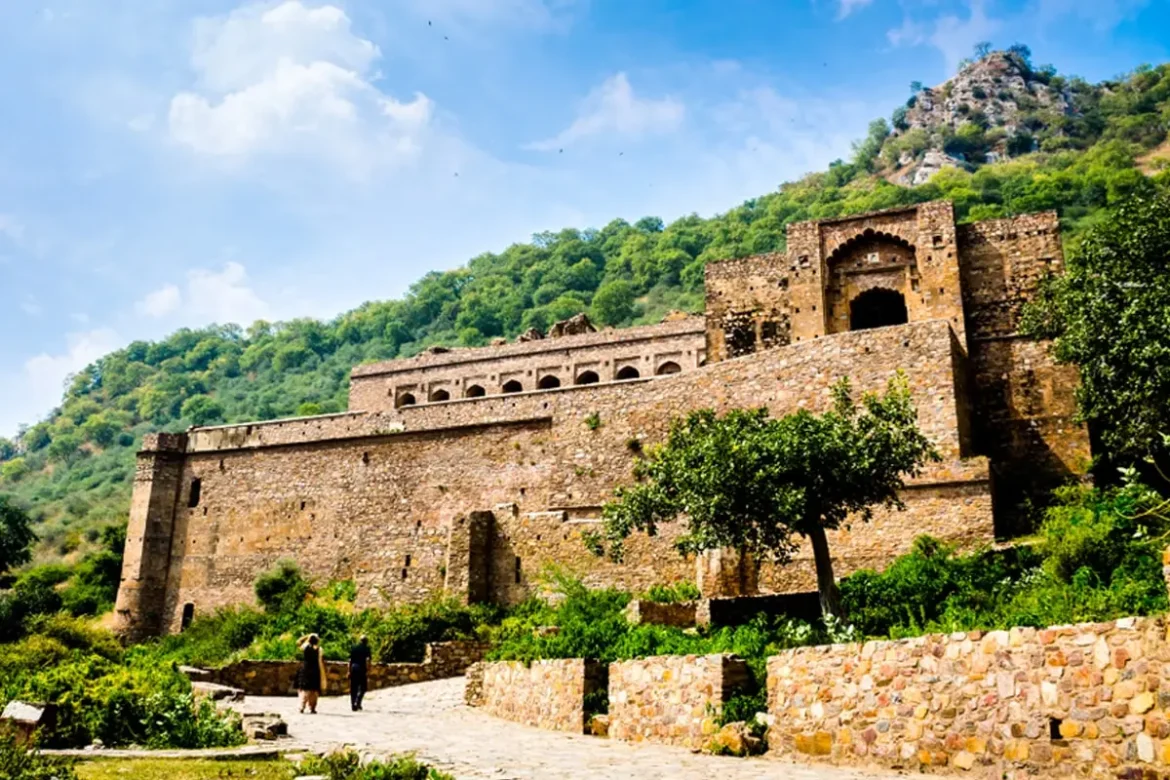Table of Contents
While others were concerned about their spookiness, I was more interested in visiting Bhangarh’s temples, designed in the Nagara architectural style. Everyone claimed to be “haunted.” ‘We could hear strange voices and noises,’ said several, while a few claimed there was nothing scary about the site. These were some of the comments from people who found out about our family vacation to India’s most haunted fort!
I remember vividly the day we visited the Bhangarh Fort in January of this year. It was an extraordinarily sunny and bright winter morning in the region of the world’s oldest folded mountains, the Aravallis. These mountains form a diagonal scar over the vast desert state of Rajasthan.
A Family Trip to Bhangarh: The Most Haunted Fort in India
I chose a bright yellow outfit that could blind even the most dangerous hovering ghosts in the fort. But why? In South India, it is believed that wearing black and having open hair attracts ghosts; thus, I made an effort to dress differently.
We began our journey to the most haunted fort in India, Alwar. On the way, we stopped at the famed Chand Baori in Abhaneri. This warrants another blog entry, but for the time being, let us turn our attention to India’s most haunted fort and its bizarrely gorgeous temples.
With a prayer on my lips and a commitment that none of us would go out alone, we traveled from Abhaneri through Dausa to Bhangarh. Despite the easy journey, the area near Bhangarh appeared sparsely populated and bleak, in contrast to the other settlements on the route. From afar, what appeared to be a forbidden solitary hill turned out to be an extension of the Aravalli ridges.
The tiny road leading to Bhangarh can make one lose their senses. Not because the stretch is haunted, but because it is endowed with craters large enough to hold a flying saucer! The road leading to the fort is uneven and cobbled in several sections. There are a couple of tea stalls on either side, and that is all one can find as part of the ‘living’ experience. Furthermore, age-old banyan trees with variously shaped hanging roots and branches create an unsettling atmosphere at the Bhangarh Fort site.
As we parked our cars and headed to the entrance, I noticed a couple of visitors moving stones from the fort. Highly symbolic of their victory over the haunted fortress. Huh?
I find it inexplicable when individuals take these parts of history as if they own them. Sigh!
Bhangarh Fort’s History as the Most Haunted Fort in India.
People commonly regard Bhangarh Fort in Rajasthan as the most haunted fort in India. According to different travel advisories, the ASI has restricted night halts and stays inside the fort due to incidences of individuals disappearing at night, paranormal activity observed on the fort grounds, and other similar myths and anecdotes.
Raja Man Singh erected the fort for his younger brother, Madho Singh. Madho Singh named the property after his grandpa, Bhan Singh.
There are far too many stories about the past and contemporary events at Bhangarh Fort circulating on the internet, on news channels, and in the villages surrounding Bhangarh. These stories span from a sadhu’s curse to a magician enchanted by Queen Ratnavati, as well as droughts and famines. However, the most plausible explanation appears to be the drought, which may have contributed to the fort’s abandonment.
But ask any villager or a guide at the Bhangarh fort, and they would dismiss all of this as complete rubbish and made-up fables. Most locals no longer appear to believe in these myths. Many of them are returning to make a living in nearby Ajabgarh, indicating that the area has a high potential for becoming a popular destination for dark tourism.
First Impressions of India’s Most Haunted Fort
My initial glance at Bhangarh reminded me of the old Golconda Fort in Hyderabad. Many decades ago, Golconda, too, appeared abandoned and dismal due to a lack of refurbishment and maintenance.
The map of Bhangarh Fort near the gate is useful for navigating the fort complex’s passageways. It provides a good impression of how well-planned the fort complex was, with Havelis, temples, bazaar areas, and several quarters, including the King and Queen complexes.
I am not going to go into detail about the many portions of the Bhangarh Fort because all of the information is accessible on the Wikipedia page.
The Jhouri Bazaar appears eerie, with the remnants of a once-bustling array of stores. Upon closer inspection, you’ll notice that most of these blocks feature enclosed stairways, and surprisingly, none of the uppermost floors remain today! The Bhangarh Fort’s bazaar is quite large, with small passageways branching off further.
The entrance to the Bhangarh Fort is located near the end of the bazaar. Upon entering the fort, to the right is the magnificently decorated Gopinath Temple, and just a few yards to the left is the Someshwar Temple, which has a water tank alongside it.
Important architectural structures are within the Bhangarh Fort.
The Nagara-style architecture of the Someshwar temple houses a Shiv ling in its sanctum. While floating over the temple’s entrance next to the tank, I could hear anklets tinkling. Surprisingly, neither my husband nor my son could hear anything, and no one was in the vicinity. We’d all heard legends about this haunted fortress, so I assumed I was hearing things.
Built uphill, the main palace reportedly stands seven stories tall. Unfortunately, just three of the seven remain as of now. This complex is accessible only via a steep ramp.
As a pleasant surprise, the lawn that spans between these two temples is well-kept, and palm trees stand tall and disciplined as if bound by the master’s spell.
The walled palace is crumbling, yet relics of a golden past remain visible. The view from above the king and queen’s chambers is stunning. If Instagram had existed then, I’m sure these views would have trended organically!
The forested Kewda (Kewra) area
Our guide (who claimed to be a local rather than an authorized guide) took a detour. He took us down a narrow path to a miniature forest. The stark contrast between this zone and the dull Fort region took us aback. This section of the Bhangarh Fort was lush green, with peacocks and birds perched on the branches of ancient trees.
He took us to the roots of a tree that purportedly had a natural spring at its top. He said that the water that oozes from here is a source of water for the Bhangarh Fort tanks.
It sounded both believable and unbelievable. The entire city of Bhangarh appears curiously dry and drought-prone, but only this area receives a steady flow of water. Nobody believes that such vegetation survives in this isolated place, especially during the winter. It does look like an oasis in the middle of a desert.
However, during the monsoons, these mountains become lush with greenery, providing an entirely different perspective.
The Nagara style of construction within the Bhangarh Fort
Whether haunted or not, the fort’s remains bring glory to a bygone era through their architectural splendor. The temples reflect a magnificent Nagara architectural style. After seeing the intact temples, I pondered if the theory of spirits and ghosts was accurate! How can one reconcile the ruins of the other elements of the Bhangarh fort complex with the nearly repaired and undamaged constructions of these temples?
Built on a raised platform, the Gopinath Temple boasts beautifully carved sculptures and elegant ceilings. The sanctum contains no idols, unlike the Someshwar Temple.
Bhangarh Fort still haunts me.
Our family trip to Bhangarh was memorable, but two incidents stand out: the sounds of anklets around the water tank area, which only I could hear, and the sight of a twisted hanging root that looked like a hanging man on a banyan tree.
Let me know if you can spot him in my photograph of the creepy tree below.
How to reach Bhangarh Fort by road.
- We went to Bhangarh Fort on a road excursion from Alwar. Our first stop was Abhaneri, followed by the fort.
- The travel time from Abhaneri to Bhangarh is around 90 minutes for 65 kilometres and 140 minutes for 90 kilometers. It takes approximately 6 hours to get by car from Delhi.
- You can also access the fort from Jaipur. The distance from Jaipur to Bhangarh is 85 kilometers. It takes approximately 90 minutes to reach Bhangarh.
By Air.
The nearest airport is in Jaipur.
By train.
The nearest train station is either Dausa or Bhan Kari.
The best time to see the Bhangarh Fort and its many temples.
The optimum months for a Rajasthan visit are October and March. The best time to visit Alwar and Bhangarh is during the monsoon season, when the Aravalli Mountains bloom with greenery. Additionally, while in Alwar, visit the Moosi Maharani Ki Chhatri.
Travel Tips
- The ideal approach to visiting Bhangarh is to stay in Alwar and explore many other surrounding attractions.
- Alternatively, take a vacation from city life and enjoy some wildlife at Sariska Reserve before visiting Bhangarh, which is only a few hours away from Sariska Wild-Life Sanctuary.
- Pack food, snacks, and potable water for your road trip, and remember to fill the vehicle’s fuel tank. There are very few inns, dhabas, or gas stations along the way. So stock up!
I hope this information helps you organize your visit to the Bhangarh Fort.
Also, have you ever visited Bhangarh or any other purportedly haunted forts in India or abroad? If so, please share your stories with me in the comments.

